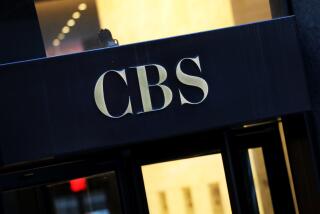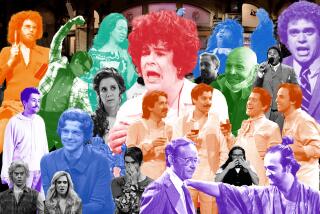ACOUSTICAL DISASTER : MUSIC CENTER BRINGS ‘BEGGAR’S’ TO EMBASSY
After two decades of false promises, false starts, fickle affairs, artistic tokenism and dilettante management, the Music Center Opera Assn. has decided to take its mandate seriously at last.
At least the new management, under the leadership of Peter Hemmings of London, says it is taking the mandate seriously.
That’s nice.
Unfortunately, the first ambitious step of the new regime--10 performances of “The Beggar’s Opera” by the Opera Theatre of Saint Louis at the renovated Embassy Theater downtown--turns out to be a dangerous stumble. And that puts it kindly.
The work itself, a quaint antique dating back to 1728, really cannot be called an opera in any conventional sense. It is a gentle sociopolitical diatribe and, perhaps, a dated operatic spoof in which the words count a lot--and there are lots of words here--while the music counts only a little.
John Gay dotted his verbose landscape with a series of borrowed ballads and period ditties. They must have amused 18th-Century British revelers but tend to evaporate in the rarefied California air of the late 20th Century.
“The Beggar’s Opera” is of undoubted historical importance. Some chroniclers like to label it the world’s first musical comedy. It would make an interesting, esoteric gift for the community that has everything. Los Angeles, alas, is the operatic community that has virtually nothing.
Hemmings & Co.--who claim to be “the wonderful folks” who gave us Covent Garden at the Olympics--have high hopes for the Embassy Theater. The ornate house on Grand Avenue is a stately relic of Los Angeles’ lost innocence. Though it seems intimate, it can accommodate an audience of 1,600 when the awkwardly placed side-balconies are filled.
They weren’t filled at the not-so-gala opening Thursday.
In its present playing configuration, the theater also can submerge the text in sonic mush and mangle the score. The built-in stage is a tiny, shallow, primitive platform. For this production--a production originally designed for an apple shed in Clarksville, Mo.--a thrust stage extends the playing area well into the auditorium.
Crucially, it also places the playing area under the huge dome that caps the hall. As a result, the Embassy is transformed into one big nasty echo chamber.
From a central seat downstairs, one tried in vain to catch tones that bounced in loud and merry distortion from walls to ceiling and back. From a less reverberant location in the central balcony--probably the best seat in the house--one could hear much, though one couldn’t comprehend much. From a seat downstairs at the rear, away from the dome, one struggled to hear anything at all.
One has to wonder if anyone had considered consulting an acoustician.
Even in the best of all possible worlds, it would be difficult to make the ancient “The Beggar’s Opera” a vital musico-dramatic experience. Under these conditions, it was virtually impossible. Still, one had to commend the enlightened St. Louis ensemble for trying.
And trying. And trying.
Colin Graham, the estimable director, falls back on the tired and irrelevant cliche of the play-within-a-play to set the play in motion. In the formal context of the Embassy, he can find no compelling reason to send his players into the audience, yet he sends them into the audience at regular intervals anyway. He has trouble getting his motley American cast to sound English with anything approaching consistency, and there isn’t a Cockney within earshot.
Still, he is a clever stylist, and he manipulates his band of rogues, thieves, wastrels and tarts with picturesque fluidity. With John Roslevich’s flexible skeletal set, John Carver Sullivan’s lavish-poverty costumes and an anonymous lighting designer’s atmospheric shadows, he gives Gay his visual due.
Gay gets his musical due, in a fuzzy fashion, thanks to scraggly arrangements by Raymond Leppard and Stephen Lord, that are often amusing and sometimes blissfully anachronistic. The conductorless band onstage plucks, tootles and thumps deftly, and the chorus of thugs and wenches sings, hums and even whistles with apparent aplomb.
The cast suffers only one serious miscalculation. David Parsons, the mellifluously baritonal Macheath, seems to confuse the charming British highwayman with Curly in “Oklahoma!”
Luckily, the stage is dominated much of the time by Judith Christin’s benevolently bawdy Mrs. Peachum, by Melanie Sonnenberg’s gorgeously gutsy Lucy Lockit, by Richard Best’s perfectly pompous Jeremiah Peachum, by Nancy Green’s pretty and prissy Polly, by Kallen Esperian’s tough yet tender Jenny and by Gordon Holleman’s staunchly slimy Lockit. James Daniel Frost doubles effectively as the titular Beggar and Gay’s unnecessary alter ego.
There is little wrong with this production that wouldn’t be corrected with a change of venue. But three nasty questions still nag: Did we need “The Beggar’s Opera”? Did we need it now? And did we need it here?
It was a long, frustrating night at the non-opera.
More to Read
The biggest entertainment stories
Get our big stories about Hollywood, film, television, music, arts, culture and more right in your inbox as soon as they publish.
You may occasionally receive promotional content from the Los Angeles Times.










